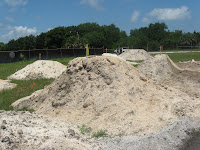"Mountain" Madness-- Archaeology in New Smyrna Beach
The more I work in the world of archaeology, the more I realize that it's everywhere! West Canal Street is undergoing construction as the city tries to improve the sidewalks and widen the road. The dirt filled dump trucks leave the construction site, taking the dirt (and the artifacts!) to a separate area. There, the trucks release the dirt, which makes huge mounds, and the archaeology begins. Brian Parker, an archaeologist from Environmental Services, Inc., monitors the site and the worker's progress while also working to sift through the huge dirt mounds.


Dot Moore, a local historian and archaeologist who works in the New Smyrna Beach Historical Museum, volunteers with Brian. With the help of another volunteer, J.P., the three tackle the mounds. The most effective method involves a high pressure hose and rakes. First, the team uses the hose to flatten the mound. While spraying it down, they keep an eye out for any artifacts that may emerge. When the dirt mountain becomes more a plateau, they use their rakes to continue sifting through the dirt and sand. Keeping their eyes out for anything that is a different color, size, or shape, the team works endlessly.

Although the work may seem meticulous or unpleasant in the hot sun, finding something hidden away in the mounds feels rewarding. Each artifact has its own history. Uncovering it, therefore, helps archaeologists and historians better understand and know the little parts of the past. The little pieces help create the bigger picture. Besides glass and more glass, Brian, Dot, and J.P. also found clay marbles, Native American pottery, a doll without a head or arms, among other personal possessions. The marbles were the first massed produced type of marble. Nicknamed "commies," the marbles were Samuel C. Dyke's creation. His patented process enabled production of up to one million marbles a day in his Akron, Ohio factory.
After hosing and raking over 15 sand mountains, the team anticipates another 20 truckloads to arrive. Unfortunately, time constraints and the manner of "excavation" at the site requires the team to resort to rescue/salvage archaeology rather than a more scientific, organized approach. Though the process is imperfect, the artifacts gathered can reveal much about New Smyrna's history near the turn of the century.

Probably unaware, the citizens of New Smyrna live near small mountains of dirt pulled from the area. Unbeknownst to them, artifacts ranging from the late 1800s to the mid 1900s are present. Hidden in these mounds are bottles, glass fragments, and other glass objects that came from the businesses near Canal Street. Sandborn maps, originally used to assess fire insurance liability for city buildings, enable Brian to know the location and function of individual businesses. The bottles can be dated based on the shape of the necks, the type of lip, writing on them, the presence of mold lines. Specific characteristics indicate a specific production period. The presence of glass, thus far, surpasses any other type of artifact. In order to curb collecting fragments that do not reveal much, if anything, about the past, Brian only keeps full bottles or fragments with writing or other indentifiable attributes.

Dot Moore, a local historian and archaeologist who works in the New Smyrna Beach Historical Museum, volunteers with Brian. With the help of another volunteer, J.P., the three tackle the mounds. The most effective method involves a high pressure hose and rakes. First, the team uses the hose to flatten the mound. While spraying it down, they keep an eye out for any artifacts that may emerge. When the dirt mountain becomes more a plateau, they use their rakes to continue sifting through the dirt and sand. Keeping their eyes out for anything that is a different color, size, or shape, the team works endlessly.

Although the work may seem meticulous or unpleasant in the hot sun, finding something hidden away in the mounds feels rewarding. Each artifact has its own history. Uncovering it, therefore, helps archaeologists and historians better understand and know the little parts of the past. The little pieces help create the bigger picture. Besides glass and more glass, Brian, Dot, and J.P. also found clay marbles, Native American pottery, a doll without a head or arms, among other personal possessions. The marbles were the first massed produced type of marble. Nicknamed "commies," the marbles were Samuel C. Dyke's creation. His patented process enabled production of up to one million marbles a day in his Akron, Ohio factory.
After hosing and raking over 15 sand mountains, the team anticipates another 20 truckloads to arrive. Unfortunately, time constraints and the manner of "excavation" at the site requires the team to resort to rescue/salvage archaeology rather than a more scientific, organized approach. Though the process is imperfect, the artifacts gathered can reveal much about New Smyrna's history near the turn of the century.